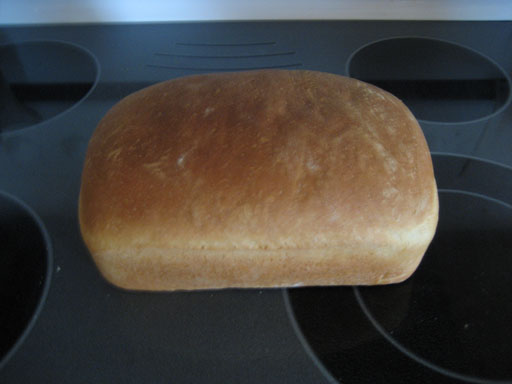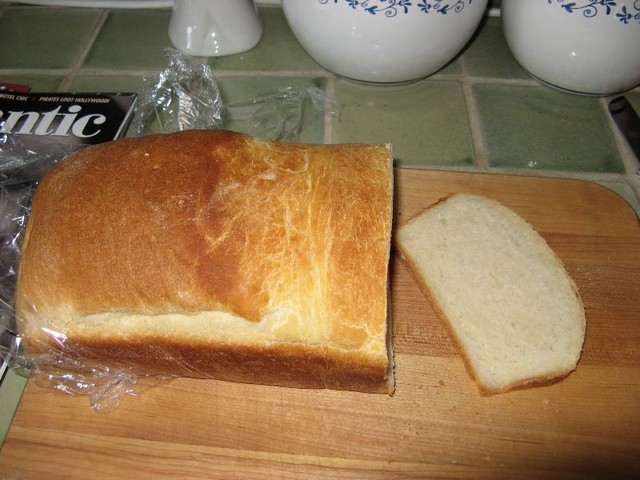How to bake bread
November 10th, 2007 at 3:54 pm (Cooking)
The idea of baking bread carries with a sense of arduous labor: lots of stirring, lots of kneading, lots of work. I’ve been curious about it for a while, but who has the time for all that work when you can get a loaf of bread at the store for $2.19?
The other day, I came across a blog entry (by “The Simple Dollar”) titled Homemade bread: cheap, delicious, healthy, and easier than you think. Well, I could hardly pass up a challenge like that! Just how easy is it to make bread, I wondered?
It turns out: not hard at all. It’s not even that much work. The only trick having about three hours when you’ll be at home and can wait out the rise phases. The actual work you do is minimal, between the waiting bits.
The post I linked to above has a nice extended set of instructions (with photos) for how to make bread following a simple recipe. For brevity, I’d like to excerpt (and paraphrase) the actual recipe here:
- 1/4 cup milk
- 5 teaspoons sugar (or 1 1/2 tablespoons)
- 1 teaspoons salt
- 5 teaspoons butter (or 1 1/2 tablespoons)
- 1 package active dry yeast (you can get yeast near the flour at your local grocery store)
- 2 1/2 to 3 1/2 cups flour (get unbleached white for your first attempt)
- Corn starch or nonstick cooking spray (to prevent the bread from sticking to the bowl or pan)
- Warm up the bowl and mix the yeast with warm water.
- Melt butter in the microwave and add butter, milk, sugar, and salt to the yeast. Stir.
- Add 2 cups flour and stir until it is absorbed.
- Continue adding 1/4 cup of flour every minute (while stirring) until the dough just barely sticks to your finger.
- Drop dough onto floured surface and knead for 10 minutes.
- Form dough into a ball, put in a clean bowl, cover with a towel, and let it rise in a warm place for 1 hour.
- Punch the dough a few times to cause it to shrink back down a little. Spread dough out into a flat rectangle, as wide as your bread pan is long and 1.5 times as long as it is. Roll it up and stick it in the pan, seam side down. Cover with a towel and let it rise for another hour.
- Bake it in the oven at 400 F for 30 minutes. Done!
Challenges:
- My yeast packet didn’t indicate how to mix it up; it only had instructions for how to put it into a bread machine, not how to make it yourself (which I found amusing). Those instructions said to use 1/4 cup water. The post I mention above says to use “something along the lines of” one cup of water. So I used one cup of water. It seems like this might actually matter, but maybe extra water just calls for a bit of extra flour, so it evens out.
- It was a rather chilly day here in southern California (mid-60’s) so there wasn’t a “warm” place for the dough to rise in my house, and I didn’t feel like wasting oven heat for two hours. So it may not have risen as much as it could have.
- I only had bleached flour, not unbleached flour. ;)
- I had neither cornstarch nor nonstick spray. I did have a nonstick bread pan, though.
- I decided to experiment with spreading some butter on top of half of the loaf before baking it. This gave one side a “stretched” look from where my knife disturbed the yeast factory. Tastes fine, though.
Despite these formidable obstacles, what came out in the end was… a fantastic loaf of white bread!
 |
 |
| The Simple Dollar’s end result | My loaf of bread |
The final instruction from The Simple Dollar is to “Let it cool down completely before slicing.” He’s kidding , right? Like you’d ever invest all of that effort, wait three hours, and not want to savor some fresh-baked, hot bread? Pshaw. Sure, it’s easier to slice when cooled, but it’s oh-so-tasty when it’s hot. :)
There’s something very satisfying about eating bread I baked. Maybe it’s that bread is such a symbol of adult independence (being the “bread-winner”) or just the feeling of being able to take “raw” materials and turn them into something refined and edible. Thumbs-up.
jim said,
November 11, 2007 at 1:15 am
Yay, you! You seem to have comfortably mastered the vague “something along the lines of” [it really is variable] and earned bonus points for having a “control” case (butter on top).
Heuristics Inc. said,
November 15, 2007 at 11:52 am
Excellent. We make bread all the time, but we use the bread machine, which means you can do things like tell it to have the bread hot and ready for you when you wake up, and waking up to the smell of fresh bread is heavenly. I think bleached flour vs. unbleached is no real difference cooking-wise, but unbleached is better for the environment. And who needs actually white bread instead of kinda white bread, anyway?
-bill
Jeff said,
January 15, 2008 at 6:53 pm
Congrats on your first bread! Answers to your questions: Amount of water doesn’t really matter, but 1/4 cup of warm water is fine for growing your yeast. A pinch of sugar (known as “proofing”) is good; you’ll know if the yeast (particularly if it’s a little old) is alive pretty soon. The more water you put in here, the more flour you are going to need to add in the “adjustment” phase. A warm place: preheat your oven to 150 or so and turn it off. That’s a fine warm place to let dough rise. Remember to cover it with a warm damp cloth so that the surface doesn’t dry out and cause heterogeneity in the final loaf. Bleached vs. unbleached flour makes no significant difference in baking. Unbleached is supposedly a little better for you. A nonstick pan is fine. If you don’t have one, greasing the pan with butter works fine. Making a crust on top of a loaf is a bit of an art form. A traditional approach is to beat one egg white with a tablespoon of cold water and brush the top surface of the loaf with that five minutes before the loaf is done. That produces a firm shiny crust. The French typically run a knife blade across the top of the loaf before the second rise. Cut very very shallow diagonal lines in one direction across the loaf; they’ll make nice shapes once it’s done.
–Jeff
What I Learned Today » Blog Archive » Further adventures in breadmaking said,
September 20, 2014 at 10:13 pm
[…] years ago, I baked my first loaf of bread. Two weeks ago, I decided to try it again. And it failed, and here’s what I […]
Ryan said,
July 9, 2024 at 7:33 am
I love that you preserved The Simple Dollar bread recipe because their site has been down for quite some time and it’s my go-to bread recipe :)
Vj said,
December 8, 2025 at 11:22 am
I had this recipe written down since 2016 (the paper has suffered enormously over time and I wanted to rewrite) then today saw that the site was no longer up, THANK YOU for this!! ????